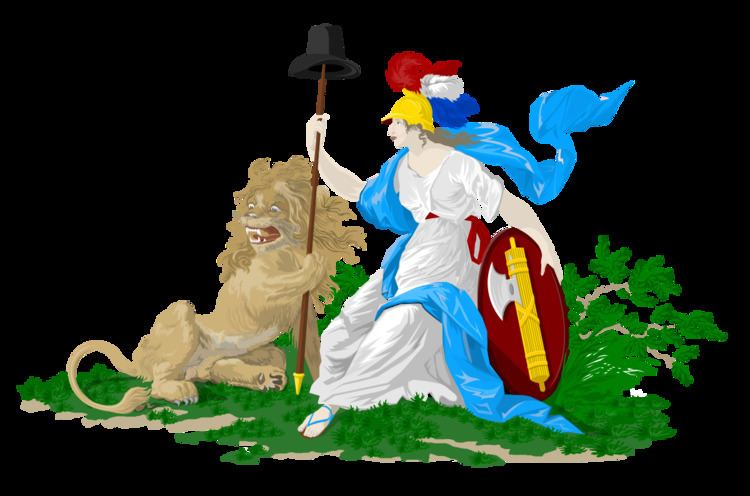 | ||
The Dutch Maiden (Dutch: Nederlandse Maagd) is a national personification of the Netherlands. She is typically depicted in a Roman garment and with a lion, the Leo Belgicus, by her side. In addition to the symbol of a national maiden, there were also symbolic provincial maidens and town maidens.
Contents
Dutch Maiden
A Dutch Maiden has been used as a national symbol since the 16th century.
During the Dutch Revolt, a maiden representing the United Provinces of the Netherlands became a recurrent theme in allegorical cartoons.
On 25 May 1694, the States of Holland and West Friesland introduced a uniform coin design for the United Provinces, showing a Dutch Maiden leaning on a bible placed on an altar and holding a lance with the Cap of Liberty.
During the French occupation, the short-lived Batavian Republic adopted the Dutch Maiden as its main symbol. The symbol was depicted on the upper left corner of the Batavian Republic's flag, with a lion at her feet. In one hand, she holds a shield with the Roman fasces and in the other a lance crowned with the cap of liberty.
The Dutch Maiden continued to be used as a symbol after the foundation of the Kingdom of the Netherlands in 1815. She was integrated into a number of 19th century monuments, including:
The theme of the Dutch Maiden still appears now and again. For example, in a political song in his 1977 oudejaarsconference, comedian Wim Kan made a reference to the Dutch Maiden:
Maiden as a provincial symbol
Starting around the time of the Renaissance, it was not uncommon for a Dutch province to be symbolised by the image of a maiden, e.g. "the Maiden of Holland".
Maiden as a town symbol
A "town maiden" (stedenmaagd) was sometimes used to symbolize a Dutch town, e.g. "the Maiden of Dordrecht".
Maiden of Dordrecht
On a relief on the 16th century Groothoofdspoort in Dordrecht, the Maiden of Dordrecht, holding the heraldic shield of Dordrecht, is seated in the symbolical Garden of Holland. She is surrounded by the heraldic shields of 15 cities. The same theme was the subject of a 1596 gift to the St. Janskerk in Gouda by the Dordrecht city council. From 19 to 23 July 1572, Dordrecht had been the scene of the first independent meeting of the provinces rebelling against Spanish rule.
In these symbols of Dordrecht, the heraldic shields are (clockwise from Geertruidenberg, the city shield on the "gate" of the garden) for the following towns: Geertruidenberg, Schoonhoven, Hoorn, Weesp, Leerdam, Naarden, Muiden, Medemblik, Grootebroek, Monnickendam, Enkhuizen, Asperen, Heusden, Schiedam and Vlaardingen.
